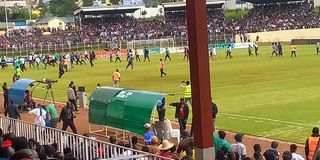
Fans take cover at Gusii Stadium in Kisii during the FKF Premier League match between Gor Mahia and Shabana FC on May 4, 2025.
The much-hyped Nyanza Derby featuring newly promoted Shabana FC and league giants Gor Mahia on Sunday, May 4, should have been a proud day for Kenyan football, but regrettably descended into a spectacle of hooliganism, tribal rivalry, political undercurrents, and administrative failure. The ugly mayhem at Gusii Stadium left more than 70 fans injured.
The match, meant to showcase the resurgence of local football, instead served as a damning indictment of everything that ails the Kenyan game: ethnic fault lines, weak governance, crowd mismanagement, and political meddling.
The Gusii Stadium, with a modest capacity of 12,000, had fans at the gates by 8am and was full by 11am, 3 hours before kickoff. Fans who were present tell accounts of confusion about the ticketing process and a dangerously overcrowded venue, with no clear buffer zones between fans.

Fans take cover at Gusii Stadium in Kisii during the FKF Premier League match between Gor Mahia and Shabana FC on May 4, 2025.
Chaos ensued, with the match being delayed by 30 minutes. Stone-throwing replaced the earlier jubilant singing.
In the second half, a disputed corner kick and subsequent Gor Mahia goal ignited the fire. The match ended in chaos. Shabana coach Peter Okidi and his players pleaded for calm, but the referee ended the game abruptly amid the violence. In the absence of firm security control or a crisis response plan, it was every fan for themselves.
Jack Oguda, the former CEO of the Kenya Premier League, says that the ability of Gusii Stadium to hold a game of such stature should have come into question, “this was a high magnitude game, the first thing should have been to assess the viability of the venue to hold such a match. This was likely not considered.”
Ethnic lines, Political loyalties
Gor Mahia, with a storied legacy of 20 FKF Premier League titles and a fanbase rooted predominantly in the Luo community, is arguably Kenya’s most iconic club. Shabana, popularly known as “Tore Bobe,” predominantly draws its strength from the Abagusii (Kisii) community. The club recently returned to top-flight football after seasons in the cold. The two are more than just football clubs.
Local politicians have long infiltrated club structures, offering sponsorships, buying match-day tickets en masse, and using football crowds as campaign fodder.” Politicians invade because it's a natural crowd that is easy to mobilise. It allows them to interact with constituents about politics, but outside of a political moment. This is an unregulated avenue of soft power,” says political analyst and author Darius Okolla.
Shabana’s recent Premier League rise mirrors the ascendancy of ex-Internal Cabinet Security Fred Matiang’i, now lining up among the Abagusii’s presidential hopefuls. Kisii Governor, Simba Arati, is also Shabana’s Patron. Meanwhile, Gor Mahia’s legacy is synonymous with Raila Odinga’s political grip on Luo Nyanza.
Experts warn that Sunday’s derby violence screamed a darker truth: as the 2027 political arena shapes up, local football, especially among community clubs, will be the stage for proxy battles between Kenya’s political class.
Hooliganism or Politics?
Football hooliganism is not a new problem in Kenyan football, and is oftentimes seen to thrive amidst political turmoil. “Football hooliganism doesn’t erupt in a vacuum. It thrives where governance is weak, tribal identities are weaponised, and sport becomes a stage for unresolved political grievances,” says Okolla. “Politicians swarm stadiums like vultures, exploiting the crowds for photo ops and populist grandstanding,” he added.
Weeks earlier, the Mashemeji Derby on March 30th between Gor Mahia and AFC Leopards had pockets of chaos, with police using teargas to disperse fans. Kenya’s match against Gabon saw fans storm the gates. The Mumias East MP, Peter Salasya, was assaulted by sections of the crowd for what he would later say was a planned attack for “disrespecting Raila”.
It’s also at a football event where Raila got the first taste of how unpopular his ODM Patry’s pact with President William Ruto’s UDA is. The unveiling of Shabana FC’s new kit at Gusii stadium, two days after the pact's signing, descended into chaos with sections of the crowd chanting “Ruto must go.” Videos showed several people leaving the stadium as the ODM leader made his speech. Chairs were thrown between fans.
The fact that this match mirrored tribal fault lines, Luo versus Kisii, was no coincidence. In Kenya’s hyper-ethnicised politics, football sometimes is a proxy for broader communal battles. “You cannot separate community clubs, ethnicity and politics in Kenya. So, if Luhyas have a problem with Baba, by default AFC and Gor will get dragged into it, If Luos has a fall out with Kisii, Shabana and Gor will get sucked into that conflict.” Says Okolla.

Violence erupted at Gusii Stadium after Shabana and Gor Mahia fans clashed before the FKF Premier League match on May 4, 2025.
“Someone needs to tell us whether we were at a political rally or a football match. Why were presidential campaign posters being handed out during the match? Why were several fans wearing campaign T-shirts to the match?” exclaimed one fan who spoke on the condition of anonymity. “Even at the Mashemeji derby (AFC Vs Gor Mahia) I haven’t seen such chaos for a long time.”
And it’s not just about violence. It’s about legitimacy. Whichever side 'wins' the derby, politically or on the pitch, also claims cultural capital. Which is something that Okolla agrees with. “What’s at stake is ethnic pride and subtle undertones about how a community considers itself within political calculations.”
In other countries where violence has affected football, governments have taken to legislation, stadium bans, CCTV monitoring, and club accountability. In Kenya’s case, in 2021, after a spate of violence in the league, then-president Nick Mwendwa promised reforms, including digitised ticketing, club accountability frameworks, and fan zone regulation. Violence, however, still appears to rock Kenyan football even after these attempted measures.
In a bid to deal with ticketing problems for clubs, many of them moved towards digital means to seal revenue loopholes and provide some order. “Digital ticketing is useful especially for accountability purposes, because fans want to know how much money the club makes, and advance tickets help determine what security measures need to be put in place ahead of the game”. Says Jack Oguda. Despite this, many fans at the Shabana vs Gor game and several other matches still insist on showing up without tickets.
“All high-magnitude games need to be played at bigger stadiums, and we need better relationships with security agencies. If possible, clubs should involve their fans more in the security process and even hire them if possible to help manage security,” opines Jack Oguda.
FKF released a statement condemning the violence, saying that they were “deeply concerned by the unfortunate scenes of violence that occurred.” They further added that they “strongly condemn all forms of violence in our stadiums”.
In a statement, Gor Mahia, cried foul over what they termed as “pre-planned attacks.” Gor Mahia FC regrets to announce that several fans and supporters sustained injuries.” They also accused Shabana FC of poor management of its supporters. “Shabana FC also failed to take adequate measures to prevent the throwing of missiles on the field.”
In a statement, Shabana did not respond to Gor Mahia’s allegations, instead choosing to focus on the violence. “Hooliganism has and will never be our identity. We condemn the acts of hooliganism, and with the help of security agencies, we are reviewing the footage and promise to take action against those involved.”
Experts and fans alike warn that events of May 4th weren’t a fluke and are part of a broader trend. They were a loud, resounding warning. Kenyan football is at a dangerous crossroads, not just as a sport, but as a barometer of our national mood.





